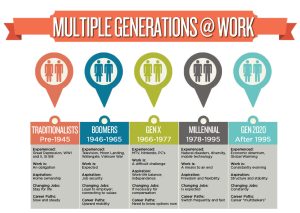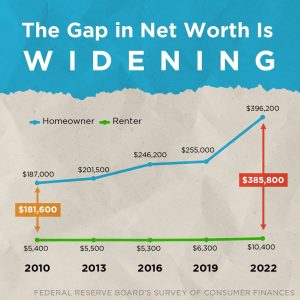In the past couple of weeks, two stories caught my attention. One decried the growing wealth gap between the young and old in America. The other highlighted the growing difference between older and younger Americans in terms of social values and morality.
Should we be surprised by either of these stories?
I think not.
Let’s look at the wealth gap first. I will get to the Social Values and Morality Gap in Part 2, which I will post tomorrow. Be sure to tune in!
A recent report by the U.S. Census Bureau said the wealth gap between younger and older Americans has increased to the widest on record, worsened by a prolonged economic downturn and inflation that have wiped out job opportunities for young adults and saddled them with housing, credit card, and college debt.
The report said the typical U.S. household headed by a person aged 65 or older has a net worth 47 times greater than that of someone under 35. It added that after adjusting for inflation, the wealth gap is now more than double what it was in 2015 and nearly five times the 10-to-1 disparity a quarter-century ago.
Why is this? Part of it is caused by the economic downturn, which has particularly hit young adults. As a college dean at the University of Illinois, I discovered that more young people are pursuing college or advanced degrees, taking on debt while waiting for a better job market. Others are struggling to pay their mortgages.
But that is not the whole story. All of us have gone through hard times at one time or another. I can recall when mortgage interest rates were 19 percent, and buying a house was simply out of the question. I can recall unemployment rates running between 7 and 9 percent and double-digit inflation–none of which made life much fun.
Perhaps it’s the way many in the so-called silent and baby-boomer generations lived and spent money. Without sounding like some old geezer, I should point out that when I was in my 20s, I didn’t have a credit card. I did have a gasoline charge card from Standard Oil, but the thought of charging meals, groceries, vacations, car repairs, etc., on a credit card was not an option. Credit cards were not the ubiquitous snares that they are today.

I paid cash for just about everything. I even paid back my student loan–though, because I was a U.S. Army veteran, I was fortunate to have a large part of my college education paid for via the GI Bill.
Today, young people are crushed under the weight of credit card debt. Why? For many, the thought of actually saving up to buy something is simply anathema. We are in the era of instant gratification. A lot of young people want things, and they want them now! So what do they do? They pull out those credit cards that aren’t already maxed out and continue to accumulate more debt.
And what about those overpriced houses? Why would a couple in their late 20s or early 30s buy an $800,000 or $900,000 house with 5% down, an adjustable-rate mortgage, a balloon second mortgage, and monthly payments of $5,000 or $6,000?
Why? Because they just HAD to have THAT house—even though common sense told them that home prices nationwide are grossly over-inflated and reside within a real estate bubble that will eventually burst as they always do.
Call me old-fashioned, but I can guarantee I would not have done that when I was starting out. Yet that is what many Gen Xers, Gen Yers, and millennials did or are doing. And now, many are suffering because of the choices they made.
The Census Bureau has created questions about the government safety net that has sustained older Americans on Social Security and Medicare amid cuts to education and other programs, including cash assistance for poor families.
“It makes us wonder whether the extraordinary amount of resources we spend on retirees and their health care should be at least partially reallocated to those who are hurting worse than them,” said Harry Holzer, a labor economist and public policy professor at Georgetown University who called the magnitude of the wealth gap “striking.”
Wait a minute! The money that retirees get from Social Security and Medicare is money they pay into the system all their working lives. Are they supposed to feel guilty about that? Older Americans paid into a system to supplement savings and private sector retirement plans such as profit sharing, employee stock ownership, and savings incentive plans.
Social Security and Medicare are NOT complimentary entitlement programs. They are NOT welfare plans for retirees. The money retirees take out of Social Security, and Medicare is money they have loaned to the federal government. The fact that the federal government spent that money unwisely or delved into it to fund other programs is not the fault of those who made good-faith payments into the system.
The numbers in the Census Bureau report are striking. For example, the median net worth of households headed by someone 65 or older is $410,000. That is 42 percent more than in 1984 when the Census Bureau first measured wealth by age.
According to the Federal Reserve Bank of St. Louis, the top 10% of American households account for 66.9% of total household wealth. As such, the average values discussed in the previous sections are skewed higher by a relatively small portion of the population.
The median (middle value) is often more useful when dealing with asymmetrical data. The chart below shows the median income and net worth among American households based on the age of the reference person.
| Age Group | Median Income | Median Net Worth |
| 18-34 | $60,530 | $39,040 |
| 35-44 | $86,470 | $135,300 |
| 45-54 | $91,880 | $246,700 |
| 55-64 | $82,150 | $364,270 |
| 65-74 | $60,530 | $410,000 |
| 75+ | $49,070 | $334,700 |
| All Households | $70,260 | $192,700 |
Data source: Federal Reserve 2022 Survey of Consumer Finances (SCF)
The chart shows that the 2022 SCF reported a median income of $70,260, meaning 50% of households reported less income and 50% reported more. Similarly, the 2022 SCF reported a median net worth of $192,700, meaning 50% of households had less wealth and 50% had more wealth.
According to the Pew Research Center analysis, the median net worth for younger-age (18-34) households was $39,040, down by 68 percent from a quarter-century ago when adjusted for inflation, etc. In all, 37 percent of younger-age households have a net worth of zero or less, nearly double the share in 1984. However, among households headed by a person 65 or older, the percentage in that category has been largely unchanged at 8 percent.
Net worth includes the value of a person’s home, possessions, and savings accumulated over the years, including stocks, bank accounts, real estate, cars, boats, or other property, minus any debt such as mortgages, college loans, and credit card bills. Older Americans tend to hold more net worth because they are more likely to have paid off their mortgages and built up more savings from salary, stocks, and other investments. The median is the midpoint and thus refers to a typical household.

Households headed by someone under age 35 saw their median net worth reduced by 27 percent in 2022 due to unsecured liabilities, mostly a combination of credit card debt, mortgages, and student loans. No other age group had anywhere near that level of unsecured liability acting as a drag on net worth. The next closest was the 35-44 age group, at 10 percent.
Among the older-age (75+) households, the share of households worth at least $330,000 rose to 20 percent from 8 percent in 1984.
Some younger readers may be dissatisfied with their current financial position, but virtually anyone can build wealth with the right mindset and proper budgeting. Financial experts often recommend the 50-30-20 rule, which breaks income into the three spending categories detailed below:
- Needs: 50% of income should be allocated to necessities like food, housing, utilities, and minimum debt payments.
- Wants: 30% of income should be allocated to discretionary spending, such as travel, entertainment, and luxury items.
- Savings: 20% of income should be allocated to debt payments (above the minimum) and retirement savings.
The last category is particularly important. With the right investments, savings can grow in value over a lifetime. An index fund that tracks the S&P 500 is a great option for most people, and owning an S&P 500 index fund is an excellent way to build wealth.
The S&P 500 measures the performance of 500 large U.S. companies. The index includes growth and value stocks from every market sector, collectively accounting for almost half of global equities by market capitalization. In short, an S&P 500 index fund lets investors spread money across many of the world’s most influential businesses.

There are three reasons to own an S&P 500 index fund. First, the S&P 500 beat virtually every asset class over the last decade, including international equities, real estate, precious metals, and fixed-income. Second, most professional asset managers underperformed the S&P 500 over the last decade. Third, the S&P 500 has produced a positive return over every 20-year period.
The problem is that too many people in the younger age group want immediate fulfillment and fall into the trap of running up an enormous credit card, mortgage, or bank debt to have that fantastic home theater setup, that new car, or a grossly overpriced house.
It is highly irritating and unfair to blame retirees for the plight of the younger generation. Unless those retirees didn’t do their job in rearing fiscally responsible offspring or, even worse, encouraged them to pile up credit card debt by promising them that a parental bailout was in the offing.
Retirees worked long and hard for whatever wealth they managed to accumulate. And, as the Census Bureau report shows, most are NOT wealthy–not when only 20 percent have a median household net worth of $300,000 or more.
Older Americans are working longer than their parents did. Both my parents were able to retire at 62. How many older Americans can do that today? Not many. Most are working well into their late 60s and early 70s.
If you don’t believe me, look who is staffing the check-out counters at Walmart, Sam’s, Costco, or your favorite supermarket.
Indeed, the whole concept of “retirement” has transformed today. The notion of spending the alleged “Golden Years” sitting on the front porch in a rocking chair, watching squirrels, and listening to birds is simply hooey.
So when economists lament that retirees have 47 times more household net worth than Generation X-ers, Millennials, or Generation Z-ers, I can’t help but think of that old Smith Barney TV commercial that said, “They make money the old-fashioned way. They earn it.”
Amen to that.
–30–
(NEXT: When Does a Gap Become a Canyon? (Part 2)
If you enjoyed this post, please consider subscribing to ForeignCorrespondent and tell your friends to subscribe. IT’S FREE! WHAT A DEAL! If you’ve received this from a friend and would like to be added to our distribution list for future blog posts, please enter your email address in the sign-up in the notifications box at:
https://ronaldyatesbooks.com/category/foreign-correspondent.
You can also find my commentaries on Substack at https://ronyates.substack.com/ and the American Free News Network at https://afnn.us.
Please feel free to comment. WE LOVE COMMENTS!


I’m in total agreement that those that have been paying into programs like social security should receive what they loaned to the government. But, once again, you are illustrating the point that government is too large and useless departments like the Department of Education needs to be removed. If Americans need to keep a budget, of federal, state, ad local governments must, also.